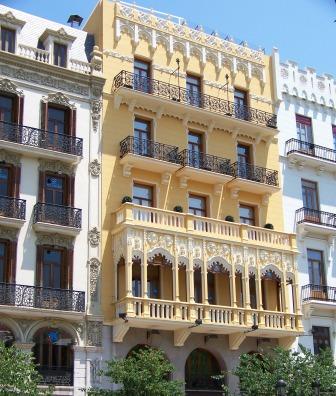
The countryside north of Valencia.
Valencia
We loved all of the cities we visited on this trip to Spain, but we probably loved Valencia the most. Maybe it was because there wasn't a long list of "things" to see and do while there--you just mostly relax and stroll around. Maybe it was because there weren't the same crowds of tourists as at the other cities with their world-class sites. Maybe it was just the appealing architecture of the city.
The countryside north
of Valencia.
We actually stayed about an hour's drive north of Valencia during our visit--so much the worse for us. The trouble was that the America's Cup boat race about to happen, not more than a couple of weeks after we arrived, and the apartment owners and hotels in the city had all raised their rates considerably. So we stayed in a small village called Quartell, outside of Sagunt, and north along the coast from Valencia. The house was nice enough--done up in a traditional country style of decor--but the town was nothing more than an industrial crossroads. Still, because there was nowhere in the village to eat, we drove twice down to the beaches, about fifteen minutes by car, and had delicious fresh seafood at local hangouts.
Valencia was conquered by the Moors in the eighth century, reconquered by the Christians in the eleventh (under the leadership of the Cid), conquered again by the Moors in the twelfth, and conquered yet again by the Christians in the thirteenth. Here is a statue of King James, called "the Conqueror," who added it to the Kingdom of Aragon in that last conquest.
With all that "back and forth" you wouldn't expect many medieval buildings to have survived, but Valencia has one of the most unique of medieval buildings. It is called La Lonja, or the Commodities Exchange, built in the Gothic style, with a huge central hall. The region around Valencia is fertile and known for the variety of its fruits and vegetables, and local merchants would haggle with sea captains who wanted to buy their produce to export it. Almost all of the buildings that have survived in the Gothic style are churches, so it was fascinating to see the same architectural techniques used for a secular purpose.

Sculpture on the doorways of the building
are also quite different than the images of saints seen on medieval Gothic churches!

Other remnants of the medieval past
include these two massive city gates--the walls of the city were unfortunately
demolished in modern times.
Modern Valencia is
an attractive city with interesting architecture and wide boulevards.
The range of building styles--modern revivals of Moorish, Gothic, Renaissance,
as well
as uniquely modern styles such as Art Deco and Art Nouveau--are all over the
city.




Especially appealing is the train
station, built in the early twentieth century in Art Nouveau style.

Inside the train station, the walls and ceilings are covered
in tilework. The Valencia orange can be seen as
a motif on the tops of the columns, and a wall fresco has an odd choice of little
boys peeing on flowers.
The most spectacularly unusual examples of architecture in Valencia, however, can be seen outside of the city center in what is called the City of Arts and Sciences, begun in 1998. It is a group of public buildings--museums, theaters, and performance halls--in a strikingly futuristic design by the architect Santiago Calatrava and surrounded by vast reflecting pools.
Both sides of this auditorium building
in front can be opened up like eyelids.
This is the parkage garage, with a
rooftop garden.

We enjoyed simply walking around the
buildings and seeing them from different angles (the two above are both the
same building--the science museum!).

The arches form interesting viewing
perspectives from one building to another, too!
The whole of the upper roof on this
building is supported only by this large cantilever in front!
In one space (above the parking garage)
there was a small botanical garden!
It was truly a unique and fascinating place!
Close this page or click here to go to the next page.